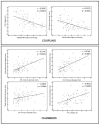Prognostic Role of Subclinical Congestion in Heart Failure Outpatients: Focus on Right Ventricular Dysfunction
- PMID: 34830705
- PMCID: PMC8625381
- DOI: 10.3390/jcm10225423
Prognostic Role of Subclinical Congestion in Heart Failure Outpatients: Focus on Right Ventricular Dysfunction
Abstract
Background: subclinical pulmonary and peripheral congestion is an emerging concept in heart failure, correlated with a worse prognosis. Very few studies have evaluated its prognostic impact in an outpatient setting and its relationship with right-ventricular dysfunction. The study aims to investigate subclinical congestion in chronic heart failure outpatients, exploring the close relationship between the right heart-pulmonary unit and peripheral congestion.
Materials and methods: in this observational study, 104 chronic HF outpatients were enrolled. The degree of congestion and signs of elevated filling pressures of the right ventricle were evaluated by physical examination and a transthoracic ultrasound to define multiparametric right ventricular dysfunction, estimate the right atrial pressure and the pulmonary artery systolic pressure. Outcome data were obtained by scheduled visits and phone calls.
Results: ultrasound signs of congestion were found in 26% of patients and, among this cohort, half of them presented as subclinical, affecting their prognosis, revealing a linear correlation between right ventricular/arterial coupling, the right-chambers size and ultrasound congestion. Right ventricular dysfunction, TAPSE/PAPS ratio, clinical and ultrasound signs of congestion have been confirmed to be useful predictors of outcome.
Conclusions: subclinical congestion is widespread in the heart failure outpatient population, significantly affecting prognosis, especially when right ventricular dysfunction also occurs, suggesting a strict correlation between the heart-pulmonary unit and volume overload.
Keywords: heart failure; right ventricular dysfunction; right ventricular/arterial coupling; subclinical congestion.
Conflict of interest statement
The authors declare no conflict of interest.
Figures



References
-
- Bozkurt B., Coats A.J., Tsutsui H., Abdelhamid C.M., Adamopoulos S., Albert N., Anker S.D., Atherton J., Böhm M., Butler J., et al. Universal definition and classification of heart failure: A report of the Heart Failure Society of America, Heart Failure Association of the European Society of Cardiology, Japanese Heart Failure Society and Writing Committee of the Universal Definition of Heart Failure: Endorsed by the Canadian Heart Failure Society, Heart Failure Association of India, Cardiac Society of Australia and New Zealand, and Chinese Heart Failure Association. Eur. J. Heart Fail. 2021;23:352–380. doi: 10.1002/ejhf.2115. - DOI - PubMed
LinkOut - more resources
Full Text Sources
Research Materials
Miscellaneous

